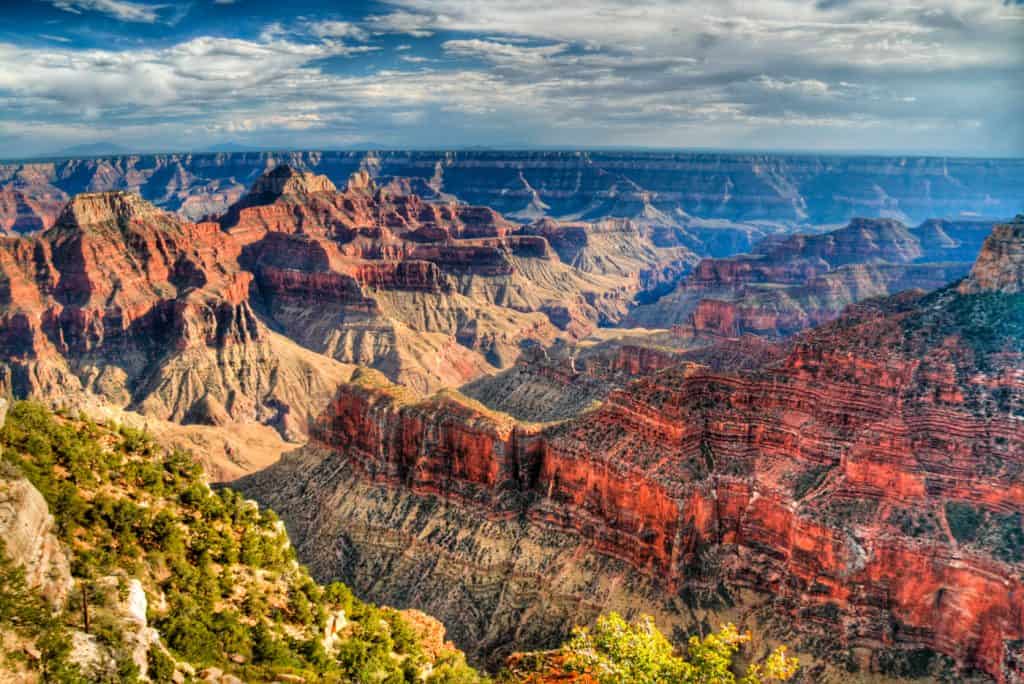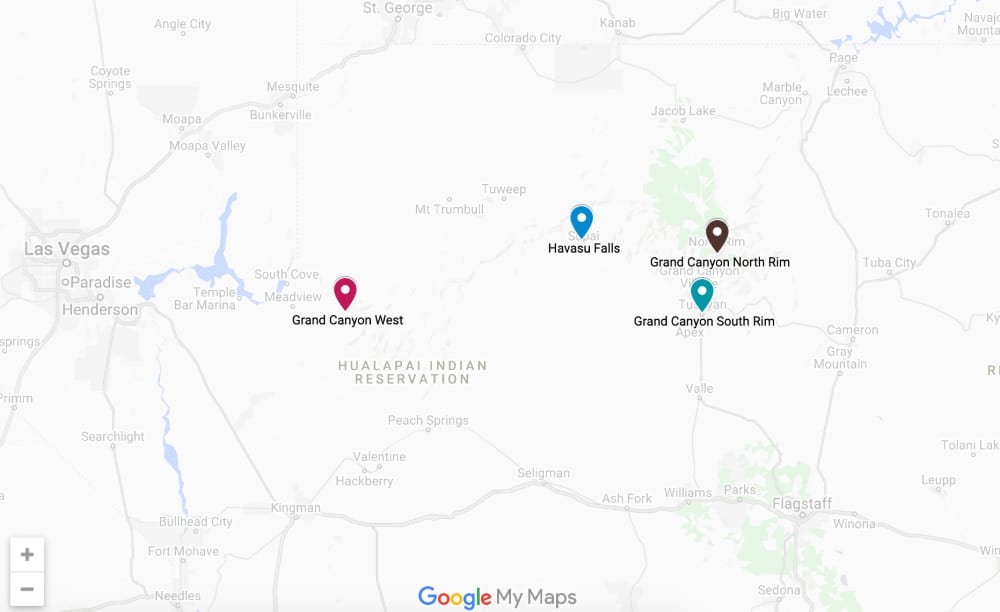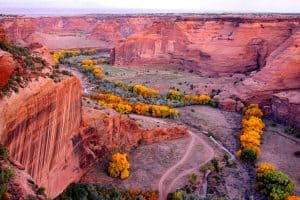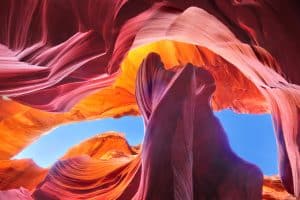- TRAVEL GUIDES
arrow_drop_down
- Canada
- United States
- Sunny Destinations
arrow_drop_down
- VIEW ALL
- BUCKET LIST
- ABOUT
- CONTACT
Unlock the Grand Canyon’s Best-Kept Secrets with This Ultimate Guide
- Travel
-
May 09
- Share post

Table of Contents
About Grand Canyon
Grand Canyon is located in northwestern Arizona, filled with history and Instagrammable spots for days. No American road trip is complete without crossing this Wonder of the World off your bucket list.
If you’re afraid of heights, don’t look down! This natural world wonder is a dizzying 1400m deep full of powerful landscapes and a variety of different terrain.
Forged by the mighty Colorado River for 70 million years, this is truly one of mother nature’s greatest works of art.
Which Part of Grand Canyon Should I Visit?
sunset at grand canyon
The sheer size of Grand Canyon can be overwhelming if it’s your first time visiting. To put things into perspective, it takes 5 hours to drive from the North Rim to the South Rim.
You can access the North and South Rim by the National Park Service. The west side is also accessible along with Havasu Falls but is owned by the Hualapai Nation Tribe — you’ll have to pay extra to explore as your park pass won’t grant you access to this section.
The natural beauty of the North Rim and the South Rim are drastically different because of the elevation difference.
If you prefer a quieter experience, visit the North Rim where you’re surrounded by nature.
The South Rim is the most visited part of Grand Canyon, offering more viewpoints. Keep in mind it can get really busy here since there is lodging on-site and other various amenities.
Best Time to Visit Grand Canyon
view of grand canyon, usa
The best time to visit Grand Canyon is from March through May, and September.
If you are planning to visit Grand Canyon during the summer (peak season), make sure to be prepared for the heat, large crowds and limited lodging availability.
During the summer months, temperatures hover around a scorching 100 ºF (38 ºC), especially if you’re inside the Canyon.
If you prefer to avoid the heat, go during November where daytime temperatures are cooler and the crowds are thinner.
Here’s a quick breakdown of the seasonal weather:
Spring (March to May): Your coats can take a hike because it’s the perfect balance of sunny skies and cool breezes. Just remember, early spring can still be a little chilly, especially in those shady areas.
Summer (June to August): Temperatures can soar to 100 ºF, so slap on the sunscreen and stock up on water.
Fall (September to November): Crisp air, fewer people, and the most incredible golden hues transforming the canyon—fall’s got it all. It’s a sweet spot if you’re not a fan of scorching heat or icy trails.
Winter (December to February): Winter brings snow and chilly conditions, especially on the North Rim, which often closes due to heavy snowfall. South Rim? Still open, but pack your warmest jacket.
Things to Do at Grand Canyon
grand canyon south rim, arizona
Grand Canyon Trails
The Grand Canyon trails is where every step unveils a vibrant canvas of rocky grandeur!
South Rim Trails:
- Bright Angel Trail: Zigzag down into the canyon on this popular trail, which offers rest stops with water—perfect for a much-needed break.
- Rim Trail: For panoramic views without the steep drops, stroll along the Rim Trail. This one’s a walk in the park with options to hop on the shuttle bus at various points.
North Rim Trails:
- North Kaibab Trail: Venture into the heart of the canyon and experience the dramatic shift in scenery and solitude. Pack layers—it can get chilly as you descend!
- Bright Angel Point Trail: Short but oh-so-sweet, this trail leads you to a jaw-dropping overlook. It’s a quick taste of magic without a time commitment.
Backcountry Hiking:
- Havasu Falls: While not a simple stroll, the reward is a shimmering blue-green oasis set against fiery red rocks. Permits are a must, so plan ahead.
- Tonto Trail: Threading the needle between the rim and the river, the Tonto Trail is for seasoned hikers craving a long expedition with epic views.
Must-See Landmarks
Get ready to fill your camera with snapshots of the Grand Canyon’s most iconic spots. These landmarks are not just pretty places; they’re the heart and soul of the park.
Grand Canyon Village: This is where the adventure begins; the hub for history buffs and nature lovers alike.
Peel your eyes for the rustic buildings that tell tales of the past, snuggled amidst views that’ll have you reaching for your camera faster than a squirrel snatches a snack.
The Skywalk: The skywalk is the main attraction at Grand Canyon West — a glass bridge that extends 70-feet over the Canyon, providing an unobstructed 360-degree view.
Desert View Watchtower: Desert View Watchtower stands tall, like a guardian of the canyon. It’s a stone structure reaching 70 feet up, touching the baby-blue Arizona sky.
Havasu Falls: Get ready to witness water perform a magic trick at Havasu Falls. The falls make a grand entrance, cascading down into pools of blue water.
It’s a little trek to get there, but the reward is a cool, refreshing dip with views to write home about!
Recreational Activities
The Grand Canyon is bursting with fun activities that can tickle your fancy whether you’re an adventure-seeker or someone who just loves soaking in nature’s wonders.
Rafting the Colorado River: It’s not just a river trip—it’s a spine-tingling adventure where each wave can make your heart skip a beat.
Mule Rides: Hop on a mule for a trot unlike any other. You’ll find these rugged animals are the limousines of the Grand Canyon, giving you a comfy seat with epic views.
Ranger Programs: Join the park rangers and outsmart any textbook with hands-on learning that’s both fun and fascinating.
Ranger programs bring the park’s history and geology to life with stories you’ll want to retell.
Tips For Visiting Grand Canyon
Havasu Falls, Havasupai Indian Reservation
- The Skywalk does not permit photography with cameras or phones. Professional photos are available for sale that you can purchase as a memoir.
- Purchase your tickets in advance online and you can save up to 20% on tours.
- Try to plan your trip during off-peak season to avoid crowds. January and February are the lowest tourist season.
- If you’re driving into Grand Canyon during the busy season, make sure to arrive before 9 AM as the parking lot fills up really quickly.
- Grand Canyon North Rim is closed to all vehicles from December 1st to May 15th. The South Rim is open year-round.
What to Bring
When visiting Grand Canyon, comfort is the key as it involves a lot of walking. Wear comfortable, sturdy shoes (ie. running shoes or sports sandals) as the terrain is rough and unstable. If you’re hiking, wear proper hiking boots.
During the summer months, a breathable short-sleeve shirt and shorts along with a light jacket would be your best option. In the winter, go for jeans and a long-sleeved shirt with a jacket.
If you’re visiting in the summer, be sure to pack essentials such as sunglasses, sunscreen, hat, reusable water container, camera, snacks and a battery pack for your phone.
Photography & Sightseeing Tips
grand canyon north rim
When you’re snapping pictures at the Grand Canyon, timing is everything! The golden hours of sunrise and sunset will make your photos pop with colors you’ve got to see to believe.
Catch the sunrise at Yavapai Point where the light gently kisses the canyon walls. For that perfect sunset shot, head over to Hopi Point to catch the sky’s fiery glow reflecting off the rocks.
Bold vistas await on the South Rim, where each viewpoint offers a new, jaw-dropping scene.
Start your journey with a burst of beauty at Mather Point, a classic first stop to get your camera warmed up.
If you fancy a glimpse of the Colorado River carving its way through the gorge, Desert View delivers a visual feast.
Capture the canyon’s splendor from the North Rim for a quieter, more secluded experience. From there, Cape Royal offers a sweeping 270-degree panorama that’ll steal your breath away – a real slice of photographer’s heaven!
Here are a few more tips:
- Pack a tripod to capture crisp, clear shots.
- Extra batteries and memory cards are a must – you’ll be clicking non-stop!
- Early birds and night owls get the perks; visit viewpoints at off-peak times to dodge the crowds.
Safety & Accessibility
grand canyon skywalk, arizona
Dealing With Wildlife
The Grand Canyon is home to a bunch of creatures, and while they might seem friendly, they’re wild at heart. Keep a safe distance from animals like squirrels, elk, and those sneaky ravens.
It’s tempting to offer a snack, but feeding wildlife is a big no-no—it’s harmful to them and could turn your peaceful encounter into a not-so-pleasant memory.
For updates on wildlife activity and tips, narrow your focus to the Grand Canyon Park’s official guidelines.
Hydration & Food Storage
Arizona’s heat can surprise you. Drink water like it’s your job, even if you’re not thirsty, to avoid the serious downer of dehydration.
And your snacks? Keep them stored like a secret stash away from critters. Using airtight containers prevents turning your backpack into a four-star critter diner.
Accessibility for Disabled Visitors
The Grand Canyon is more than just a pretty view—it’s a place for everyone.
If you’re using a wheelchair, scooter, or have other mobility needs, the park has worked hard to make sure you can still enjoy as much as possible.
Many areas around the South Rim are wheelchair friendly, like the paved Rim Trail, and the main visitor areas come with ramps and accessible restrooms.
Plus, if you’re up for a scenic ride, the shuttle buses are all set up to welcome wheelchairs aboard, so you can zip from viewpoint to viewpoint with ease.
Visitor Centers & Restrooms
The Grand Canyon has a lot of visitor centers sprinkled around, each with facilities you can use.
For a quick stop, dash into the Bright Angel Bicycles area next to the Grand Canyon Visitor Center for restroom breaks.
And if you forgot your water bottle or need a map, the visitor centers are also chock-full of useful info and goods to help make your day smooth sailing.
How to Get to Grand Canyon
view at grand canyon, usa
Getting to Grand Canyon South Rim
The closest airport near Grand Canyon South Rim is in the city of Flagstaff, about 250 miles east of Las Vegas.
From Flagstaff, you can reach the South Rim in an hour by car. If you do not have a vehicle there’s also a shuttle from Flagstaff to the park.
Getting to Grand Canyon North Rim
The quickest way to reach the North Rim is to fly into Las Vegas. From there, it’s about a 4.5-hour drive.
Final Thoughts
The Grand Canyon is one of the most breathtaking natural destinations in the world. The size and depth make it a spectacle that you need to see for yourself.
In fact, this is North America’s most iconic national park, with a wide range of awe-inspiring geological features and landscapes.
Are you ready to check one of the most impressive natural wonders of the world off your bucket list?








